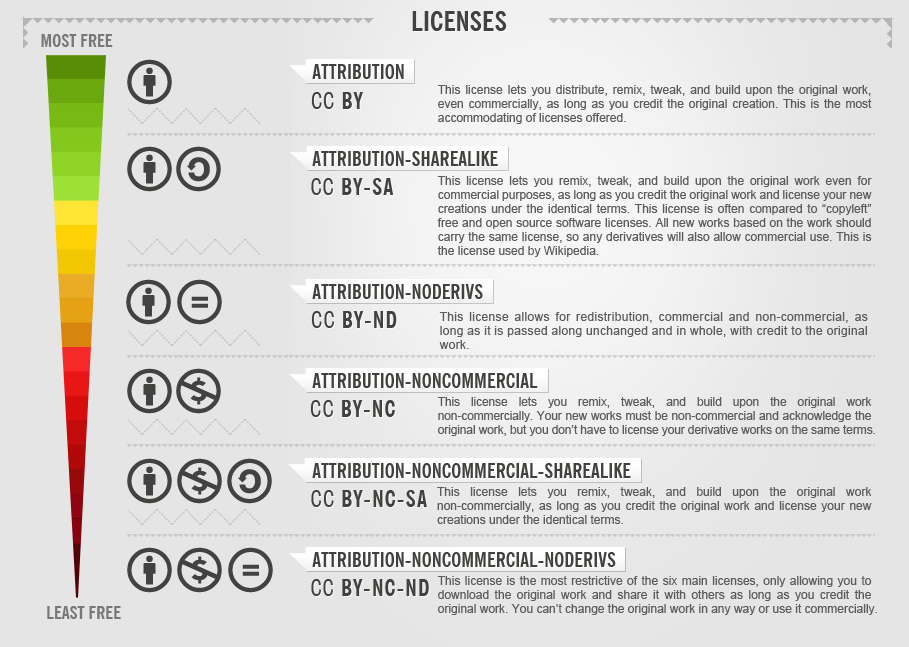
To understand open licenses, it is important to understand copyright.
Copyright is a legal protection that grants someone the exclusive rights to use and distribute work. Copyright laws vary from country to country. For more information on copyright in the U.S., check out this guide by Harvard and the other tabs on the left navigator of this GCC Copyright and Fair Use Guide.
There is a provision within copyright law that allows for the use of copyright materials, referred to as "Fair Use". Fair Use is an exception to copyright, a limitation to the exclusive rights, based on 17 U.S.C. § 107 which determines specific use as not being an infringement of copyright. However, Fair Use is a legal defense and can be considered a risk.
Creative Commons (CC) Licenses addresses that risk by working with copyright to clarify what a creator deems as fair. It clarifies how a work can be used, shared, modified, etc. There are different levels of CC licenses and it can be tricky to understand how to use the different materials.
First, let's start by understanding the different CC Licenses.
I came across this infographic by Foter that really highlights the licensing, though I also give a text explanation below.

The following information about Creative Commons license types is from https://creativecommons.
Attribution: CC BY
This license lets others distribute, remix, tweak, and build upon your work, even commercially, as long as they credit you for the original creation. This is the most accommodating of licenses offered. This license is recommended for maximum dissemination and use of licensed materials.
Attribution-ShareAlike: CC BY SA
This license lets others remix, tweak, and build upon your work even for commercial purposes, as long as they credit you and license their new creations under the identical terms. This license is often compared to “copyleft” free and open-source software licenses. All new works based on yours will carry the same license, so any derivatives will also allow commercial use.
Attribution-NonCommercial: CC BY NC
This license lets others remix, tweak, and build upon your work non-commercially, and although their new works must also acknowledge you and be non-commercial, they don’t have to license their derivative works on the same terms.
Attribution-NonCommercial-
This license lets others remix, tweak, and build upon your work non-commercially, as long as they credit you and license their new creations under the identical terms.
Attribution-NoDerivatives: CC BY ND
This license allows for redistribution, commercial and non-commercial, as long as it is passed along unchanged and in whole, with credit to you. This ND license is not OER complaint because it does not allow works to be revised or remixed.
Attribution-NonCommercial-
This license is the most restrictive of our six main licenses, only allowing others to download your works and share them with others as long as they credit you, but they can’t change them in any way or use them commercially. This ND license is not OER complaint because it does not allow works to be revised or remixed.
About the Licenses is licensed under a CC BY 4.0 International license.
Using Open Licenses
Once you understand what the different licenses are, it is important to understand how you can mix, re-mix, revise, reuse, and modify the materials you have found. Most licenses allow for that use without any issues. However, some licenses are still restricted. Some CC-licensed materials can be mixed with others, but you need to know what to do if a conflict arises. Often this consists of placing materials in separate sections so the licenses are respected.
Creative Commons License Compatibility by Kennisland, published under a CC0 license.
Disclaimer: The Open Education @GCC committee highly recommends using the services of your librarian to ensure licensing is understood as you gather materials for use. This information is presented for educational purposes and should not be considered legal advice. Page created by Christine Jones, OER Faculty Coordinator for GCC.

All guides are available under the CC-BY-NC-SA license.